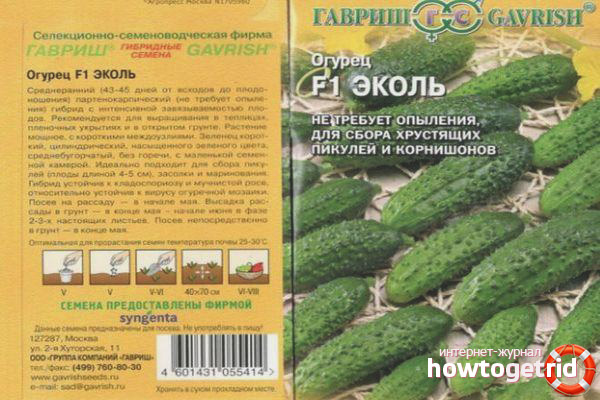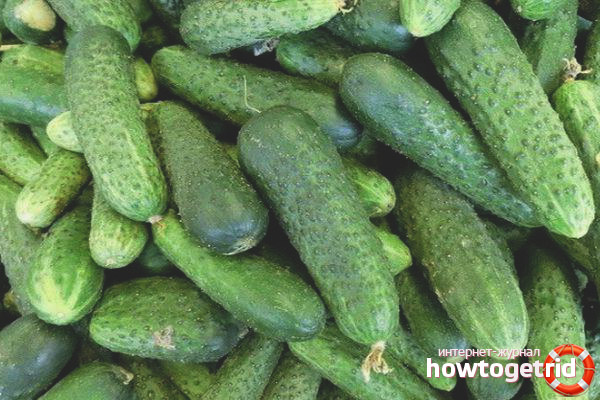The content of the article
The Ekol variety is one of the most popular hybrids. It is a unique culture, planting of which is possible in open ground and under film shelter in the second round. The variety is unpretentious in care, and, despite this, has good yields even when grown in adverse conditions. The fruits are distinguished by excellent taste. Crispy gherkins are great for preserving for the winter, as well as for making salads.
Ecol f1 bred by the Dutch breeders. In the early 2000s, it was tested, after which it was registered with the state registry of the Russian Federation. Recommended for industrial use in the North Caucasus.
This hybrid is characterized by intensive growth in the first period, before flowering. The main purpose of the plant is to cultivate in open ground using the trellis method. However, the variety can also be planted in the greenhouse.
Ekol is a variety of parthenocapic type cucumber that does not need pollination by bees and insects. It is a medium early ripening variety. From the formation of sprouts to fruit ripening, about 45 days pass.
Bush characteristic
The foliage of the plant has a dark green color. Small-sized leaves - from small to medium. The female type of flowering of a bouquet type prevails. In 1 node, up to 4 fruits can be formed.
Fruit characterization
The following features are inherent in Ekol cucumber fruits:
- cylindrical shape;
- peel of a dark green shade;
- hilly surface of the peel, dense white spikes are present;
- average length - 4 - 10 cm;
- weight -60-90 gr.;
- diameter - 2.5 cm.
Cucumbers have a delicate crisp flesh with a pleasant aroma. The fruit tastes sweetish, there is no aftertaste of bitterness.
Weaknesses and Strengths
The hybrid is highly popular among many farmers due to the following advantages:
- high yields;
- excellent taste;
- precocity
- endurance of growing conditions in the shade;
- high resistance to common diseases;
- universality of fruits in use.
The main disadvantage of cucumbers of this species is the inability of the variety to reproduce independently. The seeds that the Ekol F1 hybrid gives are not subject to re-planting. For the next planting, you need to buy new seeds, which will lead to additional costs.
In addition, with over-ripening and late harvest, the fruits may lose their palatability, gaining an unpleasant taste in the pulp. Another weakness of the culture is its susceptibility to such a disease as peronosporosis.
Planting and growing
Planting cucumbers can be done in one of two ways: by seedlings or by sowing seeds directly into the soil.
The process of growing Ekol varieties has certain features. Planting must be carried out without fail in warm soil, otherwise the plant will die. The temperature to which it is necessary to allow the soil to warm up is +15 C. This requirement is relevant for both growing methods.
The optimal precursors for planting will be crops such as potatoes, peppers, onions and cabbage.When choosing soil for planting, it is better to stop the selection on soils of medium loam type. It is recommended to land in well-lit areas protected from drafts. To avoid the threat of fungal diseases, adequate ventilation should be provided in the greenhouse.
Planting in open ground is done after the soil is completely warmed up, i.e. in the middle of May. When planting by seedlings, you should pick after the formation of the first 3-4 leaves. The recommended time for this is mid-April.
Seeds need to be pre-soaked in water with the addition of potassium permanganate. The use of growth accelerators is allowed. Then the seeds are laid out on cheesecloth and watered with warm water. After a day, when the seeds germinate, you should proceed to transplant into the soil.
Care
The hybrid is not afraid of extreme conditions, however, to ensure good crop performance, the plant needs appropriate care. The variety is hygrophilous. Watering should be done with warm water. It is recommended to form small furrows near the holes and pour water into them, and not under the bush.
Regular dressing of the plant with organic substances is also necessary. The ash solution will do the job perfectly. The procedure should be carried out during periods of vegetation and flowering. In addition, the variety requires loosening the soil. This will prevent moisture stagnation.
Ensure a rich harvest will allow the installation of supports for the plant. This will be an excellent measure for the prevention of fungal diseases that begin to multiply when the plant comes into contact with the soil.
Pest and Disease Control
The main enemies of the hybrid among harmful insects:
- Spider mite - the fight against it is to process the plant with pepper infusion.
- Whitefly - soap solution is an effective remedy against this pest.
- Melon aphid - a solution of malathion will help stop the harmful effects of this insect.
Variety Ekol F1 belongs to the best varieties of hybrids. This type of cucumber can be planted in any conditions and is suitable for preparing various dishes. The sweet pleasant taste without bitterness explains why, many farmers prefer planting this crop.
Video: Ekol F1 cucumbers











Submit